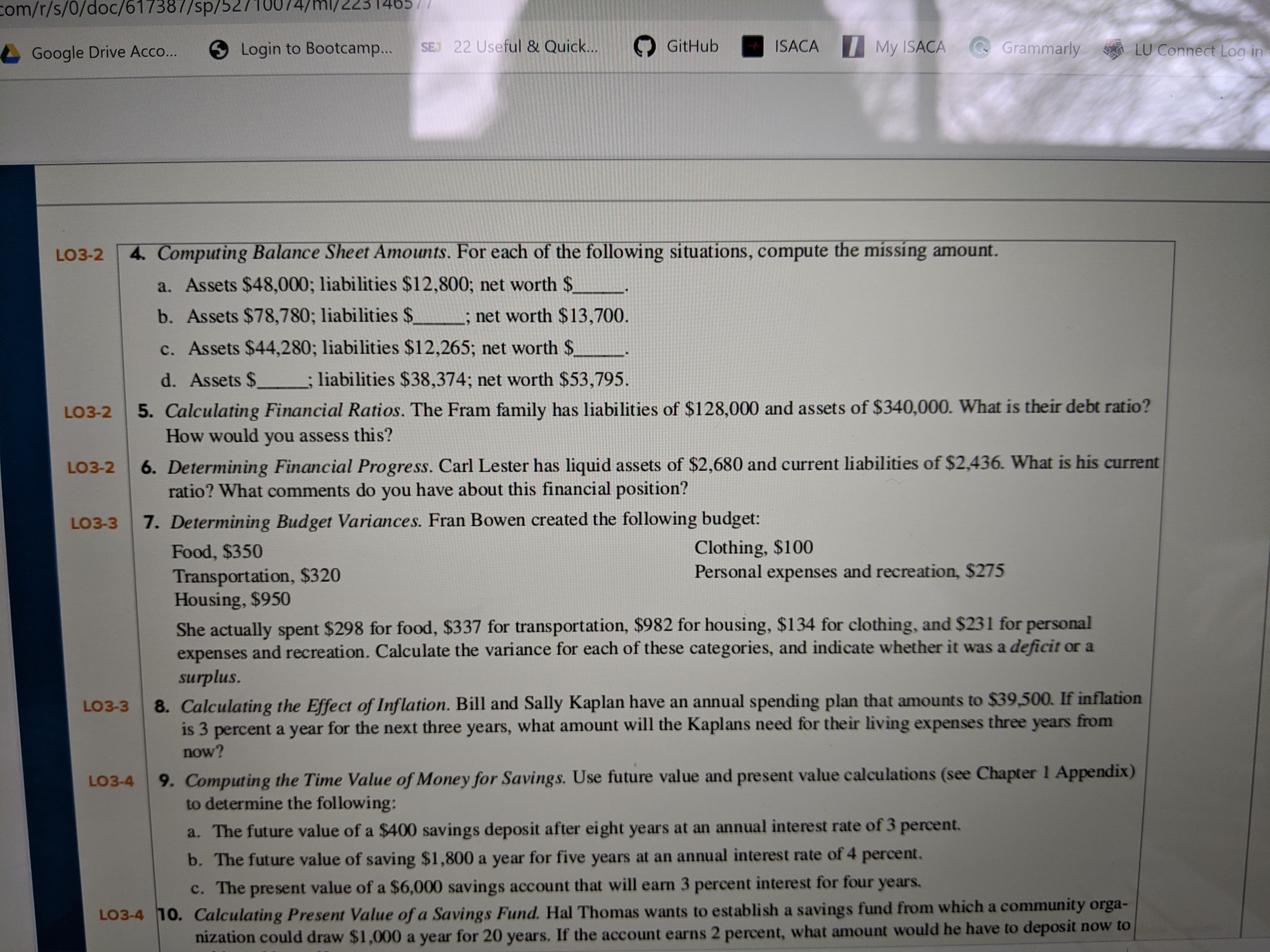Preparing a Personal Balance Sheet. Use the following items to prepare a balance sheet and a cash flow statement. Determine the total assets, total liabilities, net worth, total cash inflows, and total cash outflows. Rent for the month, $650 Monthly take-home salary, $1,950 Cash in checking account, $450 Savings account balance, $1,890 Spending for food, $345 Balance of educational loan, $2,160 Current value of automobile, $7,800 Auto insurance, $230 Household possessions, $3,400 Stereo equipment, $2,350 Payment for electricity, $90 Lunches/parking at work, $180 Donations, $70 Home computer, $1,500 Value of stock investment, $860 Telephone bill paid for month, $65 Credit card balance, $235 Clothing purchase, $110 Restaurant spending, $130 Loan payment, $80
Preparing a Personal Balance Sheet. Use the following items to prepare a balance sheet and a cash flow statement. Determine the total assets, total liabilities, net worth, total cash inflows, and total cash outflows. Rent for the month, $650 Monthly take-home salary, $1,950 Cash in checking account, $450 Savings account balance, $1,890 Spending for food, $345 Balance of educational loan, $2,160 Current value of automobile, $7,800 Auto insurance, $230 Household possessions, $3,400 Stereo equipment, $2,350 Payment for electricity, $90 Lunches/parking at work, $180 Donations, $70 Home computer, $1,500 Value of stock investment, $860 Telephone bill paid for month, $65 Credit card balance, $235 Clothing purchase, $110 Restaurant spending, $130 Loan payment, $80
Chapter3: Analyzing And Recording Transactions
Section: Chapter Questions
Problem 14PA: Prepare journal entries to record the following transactions. Create a T-account for Cash, post any...
Related questions
Question
I need help with Questions #3 and #4, please.
Thank you

Transcribed Image Text:Preparing a Personal Balance Sheet. Use the following items to prepare a balance sheet and a cash flow statement.
Determine the total assets, total liabilities, net worth, total cash inflows, and total cash outflows.
Rent for the month, $650
Monthly take-home salary, $1,950
Cash in checking account, $450
Savings account balance, $1,890
Spending for food, $345
Balance of educational loan, $2,160
Current value of automobile, $7,800
Auto insurance, $230
Household possessions, $3,400
Stereo equipment, $2,350
Payment for electricity, $90
Lunches/parking at work, $180
Donations, $70
Home computer, $1,500
Value of stock investment, $860
Telephone bill paid for month, $65
Credit card balance, $235
Clothing purchase, $110
Restaurant spending, $130
Loan payment, $80

Transcribed Image Text:14
com/r/s/0/doc/617387/sp/527
GitHub
ISACA My ISACA
G Grammarly
SEJ 22 Useful & Quick...
9Login to Bootcamp...
LU Connect Log in
L Google Drive Acco...
4. Computing Balance Sheet Amounts. For each of the following situations, compute the missing amount.
LO3-2
a. Assets $48,000; liabilities $12,800; net worth $
; net worth $13,700.
b. Assets $78,780; liabilities $
c. Assets $44,280; liabilities $12,265; net worth $.
d. Assets $
liabilities $38,374; net worth $53,795.
5. Calculating Financial Ratios. The Fram family has liabilities of $128,000 and assets of $340,000. What is their debt ratio?
How would you assess this?
LO3-2
6. Determining Financial Progress. Carl Lester has liquid assets of $2,680 and current liabilities of $2,436. What is his current
ratio? What comments do you have about this financial position?
LO3-2
7. Determining Budget Variances. Fran Bowen created the following budget:
LO3-3
Clothing, $100
Personal expenses and recreation, $275
Food, $350
Transportation, $320
Housing, $950
She actually spent $298 for food, $337 for transportation, $982 for housing, $134 for clothing, and $231 for
expenses and recreation. Calculate the variance for each of these categories, and indicate whether it was a deficit or a
surplus.
personal
8. Calculating the Effect of Inflation. Bill and Sally Kaplan have an annual spending plan that amounts to $39,500. If inflation
is 3 percent a year for the next three years, what amount will the Kaplans need for their living expenses three years from
LO3-3
now?
9. Computing the Time Value of Money for Savings. Use future value and present value calculations (see Chapter 1 Appendix)
to determine the following:
LO3-4
a. The future value of a $400 savings deposit after eight years at an annual interest rate of 3 percent.
b. The future value of saving $1,800 a year for five years at an annual interest rate of 4 percent.
c. The present value of a $6,000 savings account that will earn 3 percent interest for four years.
LO3-4 10. Calculating Present Value of a Savings Fund. Hal Thomas wants to establish a savings fund from which a community orga-
nization could draw $1,000 a year for 20 years. If the account earns 2 percent, what amount would he have to deposit now to
Expert Solution
This question has been solved!
Explore an expertly crafted, step-by-step solution for a thorough understanding of key concepts.
This is a popular solution!
Trending now
This is a popular solution!
Step by step
Solved in 3 steps with 4 images

Knowledge Booster
Learn more about
Need a deep-dive on the concept behind this application? Look no further. Learn more about this topic, finance and related others by exploring similar questions and additional content below.Recommended textbooks for you

Principles of Accounting Volume 1
Accounting
ISBN:
9781947172685
Author:
OpenStax
Publisher:
OpenStax College

College Accounting, Chapters 1-27
Accounting
ISBN:
9781337794756
Author:
HEINTZ, James A.
Publisher:
Cengage Learning,

Financial Accounting
Accounting
ISBN:
9781337272124
Author:
Carl Warren, James M. Reeve, Jonathan Duchac
Publisher:
Cengage Learning

Principles of Accounting Volume 1
Accounting
ISBN:
9781947172685
Author:
OpenStax
Publisher:
OpenStax College

College Accounting, Chapters 1-27
Accounting
ISBN:
9781337794756
Author:
HEINTZ, James A.
Publisher:
Cengage Learning,

Financial Accounting
Accounting
ISBN:
9781337272124
Author:
Carl Warren, James M. Reeve, Jonathan Duchac
Publisher:
Cengage Learning